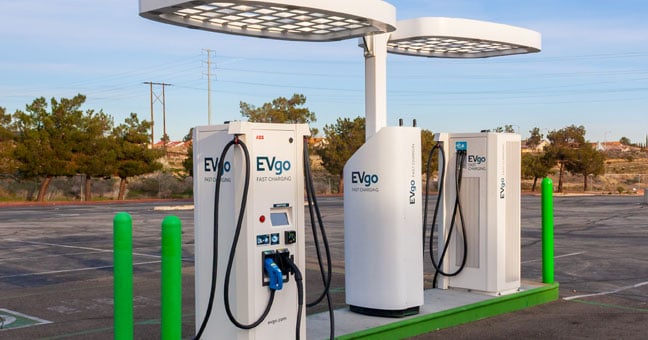

Mar 28 2023
Electric vehicles (EVs) are continuing to grow in popularity due to their environmental friendliness, cost savings, lower maintenance, and improved performance. However, one of the greatest obstacles holding back the worldwide adoption of EVs is infrastructure limitations for charging stations, especially in the U.S.
According to the Center for Sustainable Energy, “the majority of current EV owners charge at home, but to support mass adoption of EVs, including people who can’t charge at home or at work, the U.S. will need to build hundreds of thousands of charging stations.” As of 2022, only 65.9% of US households are occupied by owners (source: Statista), leaving more than 30% of US residents without the option for home charging.
This article will take a deep dive into what the EV charging landscape looks like right now, including the different types of charging, the current state of charging infrastructure, and the future of EVs.
EV charging is much more involved than pumping gas. The most important aspect to understand about charging is the types of charging and the different connection types.
There are three main types of EV charging:
Understanding EV connection types is similar to understanding the different types of phone chargers. There are 4 major EV charging connection types used in the North American EV market:
The availability and accessibility of charging infrastructure vary greatly depending on geographic location. As an example, several European countries, including Norway and the Netherlands, are leading the charge (pun intended) of EV adoption with widely available public charging stations and fast charging networks, while some developing countries have limited charging infrastructure, hindering EV adoption.
The United States, though quite a few steps behind Europe and many other regions of the world, has continued to expand its charging infrastructure with 51,768 public charging stations, totaling 133,412 ports as of March 2023 (according to the: Alternative Fuels Data Center). Most of these charging stations are level 2, with only 7,087 of those 51,768 stations equipped with DC fast charging.
The US government has taken initiative to further expand EV infrastructure, including the Biden administration’s proposed $7.5 billion investment to build 500k EV charging stations by 2030. However, there are still many challenges standing in the way of public charging expansion, including high up-front costs, limited access to public land, and the need for grid upgrades to handle increased electricity demand.
Aside from the insufficient number of public charging stations in comparison to petrol stations and the time it takes to charge, there are additional concerns that EV owners will need to consider, including:
Cost is often a factor in the adoption of any new technology. Drivers that must rely on public charging could end up spending a premium on charging depending on the type of station, location, and time of day. Additionally, at-home charging options aren’t always cheap depending on the region and utility company.
Given the variables of public charging costs, it’s impossible to give a single price. However, if we look at EVgo’s “Pay As You Go” fast charging option, specifically for Massachusetts, it costs $0.41 per kWh plus a $0.99 fee per session. EVs typically get 3-4 miles per kWh, which translates to ~57 kWh for every 200 miles (average EV range). In this example, consumers would be paying just over $24 per “fill-up” (0-100% charge).
Based on the example given above, although on the higher end, the price isn’t much different than the cost of gas. Sticking with Massachusetts, gas is currently averaging $3.27 per gallon. According to the EPA’s estimate of a 26.4 mpg fleetwide real-world average in the 2022 model year (source), 200 miles of gas range would cost $24.77. The difference between these two examples is a matter of cents.
EV drivers that rely solely on public charging would likely sign up for a monthly membership which would cost significantly less than the ~$24 pay-as-you-go rate. And some EV drivers may be able to offset public charging costs with free charging, though typically less available and more time-consuming.
Even at-home charging can be costly. The national average electricity rate is currently $0.23 per kWh, with some states, including MA, averaging as much as $0.31 per kWh (source). Using the same 200-mile range average (~57 kWh), home “fill-ups” could cost nearly $18 on the higher end. Depending on the location and utility company, this kWh rate is subject to vary and is often cheaper overnight in “off-peak” hours when EV charging most commonly occurs.
As mentioned previously, there is a lack of charging standardization across EV manufacturers which adds another layer of complexity to the already limited public charging availability. While certain charging adapters can help address this challenge, charging incompatibility can be inconvenient and confusing for EV owners.
As public charging has limited availability, it’s essential that these stations remain operational. An out-of-service EV charging station, or connector, can be quite inconvenient, especially for those fully relying on public charging, or planning their long-distance trips around specific charging stations.
Despite the challenges slowing the adoption of EVs, there are many initiatives to move the needle in the right direction. The US government, private companies, and even utility providers have been working together to improve EV charging infrastructure and make charging more affordable:
In summary, the US is making significant strides in improving EV charging infrastructure. With the continued collaboration of our government, EV manufacturers, charging networks, and utility companies, we should see quite a bit of growth in the coming years.